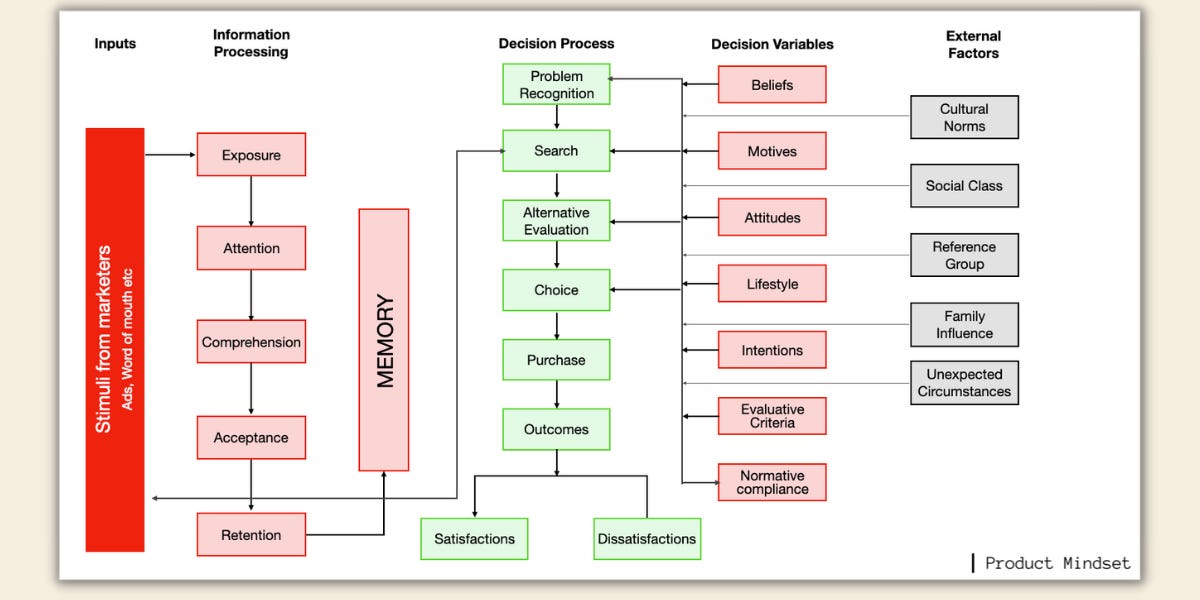This is lesson thirteen. This is towards one of our missions. Education. You’ll learn everything about marketing — from the basics to the most advanced strategies — for free, thanks to VellumWorks.
If you’ve ever wondered why people buy, donate, or join — and what actually happens before they make that choice, the EKB Model is your roadmap.
It’s one of the most comprehensive frameworks for understanding how people make decisions, blending psychology, marketing, and behaviour science into one logical process.
What is the EKB Model?
The EKB model is a consumer behaviour model that describes the process a consumer goes through when making a purchase decision, which includes problem recognition, information search, evaluation of alternatives, purchase, and post-purchase evaluation.
It is a framework that helps businesses understand how psychological, social, and environmental factors influence a consumer's journey from recognising a need to the outcome of a purchase.
The Five Stages of the EKB Model
1. Problem Recognition
Every decision starts with a need.
Something creates a gap between the current state (“I’m hungry”) and the desired state (“I want to eat”).
For charities, this could be emotional triggers like “I want to help someone in need” or “I want to make a difference.”
Your goal: Make people feel the need your organisation solves — clearly and authentically.
2. Information Search
Once a need exists, people start looking for answers.
They might Google, ask friends, or scroll through social media to find solutions.
For businesses, this is when SEO, blogs, and ads kick in.
For charities, it’s your impact stories, transparency reports, or social proof that make you stand out.
Tip: Make information easy to find and emotionally resonant. People rarely act on facts alone. They act on meaning.
3. Evaluation of Alternatives
At this stage, the audience is comparing options.
“Should I donate here or to another charity?”
“Should I buy this brand or that one?”
They weigh value, trust, emotional connection, and effort.
Your role: Help them see why you’re the right choice. Use testimonials, impact data, and a simple “why us” message that focuses on their values, not your features.
4. Purchase (or Donation) Decision
This is the conversion moment — when thought turns into action.
But it’s not just about pushing a button; it’s about removing friction.
Simplify the journey:
Short donation or checkout forms
Clear calls to action (“Feed a family today,” not “Submit form”)
Emotional timing — right story, right moment
The easier and more human the process feels, the higher your conversions.
5. Post-Purchase Evaluation
After acting, people judge whether it was worth it.
Did the experience meet expectations? Do they feel proud, satisfied, or regretful?
For charities, this is where retention is won or lost.
Send impact updates, thank-you messages, or personal follow-ups that show their action mattered.
Remember: repeat engagement isn’t built on guilt. It’s built on gratitude.
Why the EKB Model Matters?
The EKB Model shows that marketing doesn’t end when someone clicks “donate” or “buy.”
It’s a cycle. Each experience feeds into the next decision.
By understanding these stages, you don’t just influence decisions; you help people make choices that feel right for them.
And that’s the difference between marketing and manipulation.
10-Minute Exercise: Map Your Own EKB Journey
Pick one of your campaigns, or your website, and ask:
How do we make people feel the problem we solve?
How easy is it to find and understand what we offer?
Do we show clear value compared to alternatives?
How smooth is the action step (donate, sign up, buy)?
What happens after — do people feel seen and appreciated?
You’ll spot gaps you can fix immediately.
Why is this important to know?
The EKB Model reminds us that donors and supporters aren’t ATMs. They’re people with needs, values, and emotions.
When you respect that process and guide them thoughtfully through it, you build something stronger than a one-time donation: a relationship.
At VellumWorks, we believe knowledge should be free. That’s why this series will guide you, step by step, through everything from the basics to the most advanced strategies in marketing: no jargon, no gatekeeping, just education that empowers.


